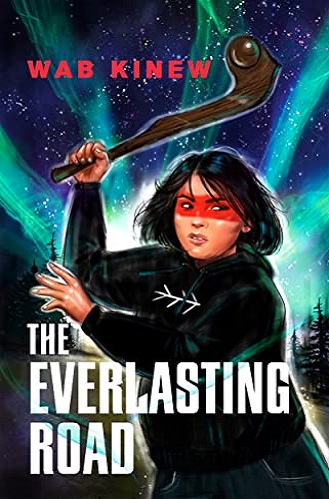Devastated by the loss of her older brother to cancer, Bugz returns to the place where she can always find solace and strength: the Floraverse. Over the past year, she has regained her position of power in that virtual world, and while the remaining Clan:LESS members still plot against her, she is easily able to overcome their attacks. Even better, she has been working secretly on a bot that will be both an incredible weapon and a source of comfort: Waawaate.
With the Waawaate bot looking exactly like the brother she misses so much—even acting like him — Bugz feels ready to show him off to Feng, who has become a constant companion in the ‘Verse. She cannot wait to team up with both friend and bot to secure her dominance once and for all. But Feng has his own issues to deal with, especially when news that his parents are alive and want to contact him threatens to send his new life on the Rez into upheaval.
As they work through their complicated feelings of grief and loss, Feng and Bugz find themselves becoming ever closer. But disturbances in the Floraverse cannot be ignored, especially when Bugz realizes that her Waawaate bot is growing in powers beyond her control.
Professional gamer-streamer creates AI of dead brother that goes on to bid for world domination? Gordon Korman called.
There’s an intrinsic hurdle to jump through in every book about gaming: the fact that video games, explained in correct English, sound… wrong. Without the use of the jargon and slang that envelops the gaming world, it’s very difficult to make a game fit into the story. The idea of Clan:LESS acting as the primary antagonist at the beginning of the story works, but the inherent awkwardness of translating a video game into words on a page makes that whole side of the story feel a little bit lost.
By far the high point of this story comes in the intersectional nature of its characters and cultures. The power that Bugz’s Anishinaabe culture brings her inside the Floraverse is powerful, and a great way to showcase Indigenous culture in a way that attracts attention from a younger audience. I was less convinced by Feng—his whole character arc was so separate from the main story that it felt like it was put there just to give him something to do—but the way his experiences as a Uyghur prisoner meld with Bugz’s own experiences creates a compelling dynamic. The story outside the game is also a high point, though I would have loved to read more about the different ways her family and friends were dealing with the grief of Waawaate’s death.
Speaking of the game, it’s time to hit on the main story, and I just need to say it: It doesn’t make enough sense. Clan:LESS is a cool idea, but having a whole clan of bigots intent on taking down Bugz herself, to the point of vandalizing sacred sites in real life, doesn’t give them much gravity or character. Nobody in the clan gets more than a few lines of dialogue, and this book shies away from on-page bigotry so much that, if I hadn’t read about their vandalism, I would have pegged the clan as nothing more than a competitive rival to Bugz.
Multiple times, the book mentions members of the clan “streaming with their usual vocabulary of racist and sexist language,” but that’s the closest we ever get to proof of their bigotry. I’m not saying every piece of Indigenous literature has to trauma-bomb, but the characters themselves don’t shy away from mentioning sensitive topics outside the game. The author’s approach is very respectful and sensitive, but it has the unfortunate side effect of creating a rather limp villain.
Now for the real villain—or, at least, the point where the plot gains some traction. The Waawaate-bot, I’ll admit, was good. Its arc worked well, from a faithful defender to an ADHD child to a malicious killing machine. There was an attempt to make the bot sow discord between Bugz and Feng, but it just didn’t work. The way Bugz manages to fight the Waawaate-bot without ever seeming like she is on Clan:LESS’s side is well done, but there seems to be no emotional struggle to it. There are plenty of physical and in-game problems to solve, but the perceived lack of any mental struggle beyond “I don’t know how to fix this and I’m frustrated” makes the climax feel much less meaningful. Bugz’s access to the mainframe of the game, and the assistance she receives from Asabikeshiinh, is another powerful example of Indigenous cultural triumph, but it doesn’t quite carry the climax to what could have been a gripping emotional high.
All in all, it is a decent middle-of-the-road read with some stand-out parts and some not-so-much parts. It has the potential to offer a safe space for many readers of diverse backgrounds. Its plot is strong but samey, its physical hurdles are strong, and its mental ones are less so. I enjoyed reading it once, but I don’t think I’ll read it again.
Happy reading!
—Matt Shipley


